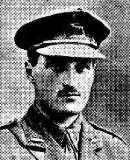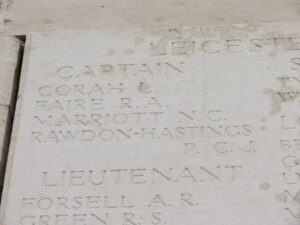The Parish of Roch sits about six miles North-West of Haverfordwest, and centres around the site of an early Castle. Roch Castle was founded in the 1250’s, although an earlier fortress may have existed here. It is supposed to have been built by Adam de Rupe, a member of a very influential family which had played an important role in the English settlement of Pembrokeshire. Roch Castle was built as one of the outer defences of Little England beyond Wales , as it is near the unmarked border which for centuries separated the English and Welsh areas of Pembrokeshire. The castle was greatly neglected after the Civil War, but in 1900 Viscount St. David began extensive restoration, and subsequent owners have continued this. It is therefore considerably altered, but the tower is unmistakable for miles around, and traces of the old earthwork bailey can be seen at the foot of the outcrop. Two of the sons of the Viscount were killed during the Great War, and the details of these men, and the others of the locality, are remembered on the marble War Memorial which is fixed to the boundary wall outside the Castle. This memorial duplicates one inside St. Mary’s Church, which also contains a fine collection of memorials to the Philipps family.

The Great War, 1914-1918
Frederick Charles Absalom, Private, 63107, Welsh Regiment. Frederick was the son of Elizabeth Absalom, Folkston Hills, Nolton Haven. His father had been presumed killed during the Boer War. Fred enlisted at Haverfordwest into the 3/4th Battalion, Welsh Regiment. He served at Gallipoli from 8 October 1915, but on 22 November 1915 was admitted to hospital suffering from dysentery, and returned to England on 15 December 1915. After recovering, Fred embarked for Salonika on 5 February 1917, and joined the 11th Battalion, Welsh Regiment, and was wounded on 14 August 1917. After recovering, he rejoined his unit, but became ill with malaria, and on 29 March 1918 embarked via Taranto for England. On 8 August 1918, Fred was posted to France, first joining the 13th Welsh on 11 August. A week later he was posted to the 14th (Swansea City) Battalion, which was attached to 114 Brigade, 38th (Welsh) Division. The Division had launched its assault across the River Ancre on 21 August 1918, capturing Thiepval Ridge and Pozieres within days. Fred would have joined up with his new unit around Longueval. The Division then drove towards the mighty Hindenburg Line, fighting at the Battle of Havrincourt, and the Battle of Epehy. A short rest period ensued, during which time the Canal du Nord was breached, so opening a passage through the Hindenburg Line. The Division then fought at the Battle of Beaurevoir, and moved up towards Cambrai, capturing Villers-Outreaux, before advancing to the Selle and onto the Sambre. Frederick was wounded during the Battle of the Selle, and died of his wounds on 20 October 1918. He is buried at St. Souplet British Cemetery, France. As far as is presently known, Frederick is not commemorated locally.
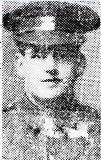
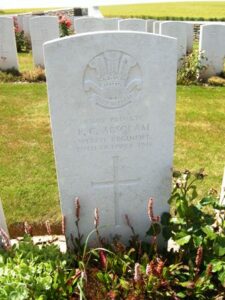
Walter Allen, Private, 2471, Welsh Guards. Walter was the son of Thomas and Martha Allen, of The Folly, Roch, Pembrokeshire. Walter enlisted at Haverfordwest into the Welsh Guards. Walter was posted their 1st Battalion, which was attached to the 3rd Guards Brigade, Guards Division. This Division has the distinction of being formed in France in August 1915. The various Guards units that had been with other Divisions were withdrawn to be brought together to create this fine formation. It remained on the Western Front throughout the war and saw its first major action during the Battle of Loos on the 25th September, 1915, remaining in the area during the coming months, where they also fought in the subsequent Action of Hohenzollern Redoubt. In July, 1916 the Division moved to the Somme, where they fought at the Battle of Flers-Courcelette, and then at the Battle of Morval, capturing Lesboeufs Village. Walter was killed in action at Morval on the 25th September, 1916. He was 20 years old. Walter has no known grave, and so is remembered on the Thiepval Memorial, France.
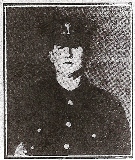
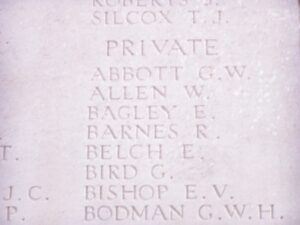
George Winfred Bowen, Private, 201578, Welsh Regiment. George was known as Fred, and was the illegitimate son of either Sarah or Hannah Bowen, of Haroldston, and the Nephew of Mary Louisa Summons (nee Bowen), of 84, Portfield, Haverfordwest. He enlisted at Haverfordwest into the 4th Welsh. He served with the 15th Battalion, which was attached to 114 Brigade, 38th (Welsh) Division. The Division had landed in France during December 1915 and had spent their first winter in the trenches near Armentieres. In June they marched south to the Somme, where they were tasked with the capture of Mametz Wood. The attack on the wood began on 7 July, but met with fierce resistance, and it took until 12 July to clear the wood. The Division suffered terrible casualties at Mametz, and were taken out of the line, and moved to Ypres to rebuild. Here they fought at the Battle of Pilckem Ridge and at the Battle of Langemarck. Fred was wounded at Langemarck, and evacuated to a nearby Casualty Clearing Station, where he died of his wounds on 20 August 1917, aged 23. He is buried at Dozinghem Military Cemetery, Belgium.
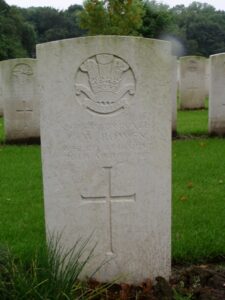
Thomas Davies, Private, 71974, Kings Liverpool Regiment. Thomas was the son of David and Amy Davies, of Nolton, Pembrokeshire, and the husband of Hilda Twigg (formerly Davies), of 7, Union Street, Gelli, Ystrad, Glamorgan. Thomas enlisted at Cardiff into the Kings Liverpool Regiment, and was posted to their 16th Labour Company. The Company was sent to the Western Front. Thomas was then transferred to the 81st Company, Labour Corps, and his Regimental Number changed to 48129. He was working with the Company at Ypres when he was killed in action on 5 July 1917, during the build up to the Passchendaele Offensive. Thomas was 36 years old, and is buried at Lone Tree Cemetery, Belgium. His brother Benjamin also fell, and is commemorated at Camrose.
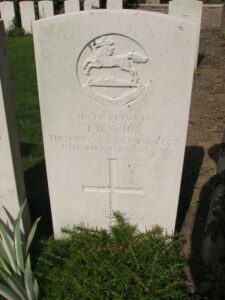
William Evans, Private, 54441, Welsh Regiment. William was the son of James and Catherine Evans, of Castle Farm, Roch, Pembrokeshire. William worked at home on his Fathers Farm before the war, and he enlisted at Haverfordwest into the Welsh Regiment after war was declared. He was posted to the 14th (Swansea) Battalion, which was attached to 114 Brigade, 38th (Welsh) Division. The Division had landed in France during December 1915 and had spent their first winter in the trenches near Armentieres. In June the division marched south to the Somme, where it captured Mametz Wood. The Division suffered terrible casualties at Mametz, and was taken out of the line, and moved to Ypres to rebuild. Here it fought at the opening Battle of Third Ypres, at the Battle of Pilckem Ridge, and then at the Battle of Langemarck. William was killed in action just after the Battle of Langemarck, on 22 August 1917, aged 22. William has no known grave, and so is remembered on the Tyne Cot Memorial, Belgium. James and Catherine received a letter from William’s Lieutenant, which read “Dear Mrs. Evans- I expect that you have already heard that your son was killed in action last week. He was hit by a shell and died instantaneously. You will be proud to know that he died doing his duty. He was one of my very best men, and a credit to his Company. His companions in his Platoon feel his loss in a way which can be second only to your own feelings. His companions write with me in expressing our deepest sympathy in your sad loss, – Yours Sincerely, E. H. Balsom.” Sadly, Lieutenant Ernest Balsom himself was killed just a year later, during the Battle of Albert.
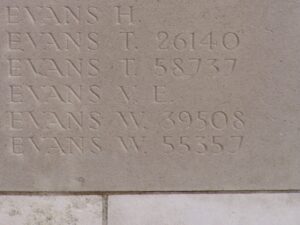
Ernest Johnson, Private, 16036, Gloucestershire Regiment. Ernest was born at Whitchurch in 1893, the son of William and Margaret Johnson. Prior to the war he worked at Roch as a Teamster, and enlisted at Haverfordwest into the 10th Battalion, Gloucestershire Regiment. On 8 August 1915 the Battalion moved to France, where they became attached to 1 Brigade, 1st Division. The Division was a Regular Army Division that had been on the Western Front since the opening Battle of Mons. The 10th Gloucester’s then joined them, and saw their first action during the Battle of Loos and the action at the Hohenzollern Redoubt. The Division was then moved south to the Somme in the summer of 1916, where they fought during the opening of the Somme Offensive at the Battle of Albert. They then saw action at the Battle of Bazentin Ridge, and the Battle of Pozieres Ridge. It was during the terrible fighting that raged around this time that Ernest was killed in action, on 18 August 1916, aged 23. He is buried at Caterpillar Valley Cemetery, Longueval, France.
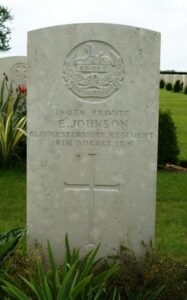
John Stuart Phelps, Rifleman, 34067, South Lancashire Regiment. John was born in 1886, the son of Moses and Frances Phelps, of New Cottage, Roch. John was a Draper prior to the war, and enlisted at Cardiff in December 1915 into the 7th Battalion, Welsh Regiment, a Territorial Cyclist Battalion. On 26 July 1916 he landed in France, and was posted to the 1/5th Battalion, South Lancashire Regiment, which was attached to 166 Brigade, 55th Division. The division was in the front line opposite the village of Guillemont, on the Somme. Here they fought at the Battle of Guillemont and the Battle of Ginchy. There was a short period of rest at Ribemont, and then the Division fought at the Battle of Flers-Courcelette and the Battle of Morval. The division moved to the Ypres salient in October 1916. It was destined to remain in this area for almost a year, stationed near Railway Wood. John was killed in action here on 18 November 1916, soon after the battalion took up positions there. He was 29 years old, and is commemorated on the Ypres (Menin Gate) Memorial, Belgium.
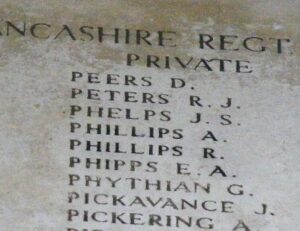
The Honorable Colwyn Erasmus Arnold Philipps, Captain, Royal Horse Guards. Colwyn was born on 11 December 1888, the son of John Philipps, the Right Honorable the 1st Viscount St. David’s, P.C. and his wife, Leonora Gerstenberg, of 3, Richmond Terrace, Whitehall, London. He was educated at Eton and Sandhurst. At the age of 20 he received a Commission into the Royal Horse Guards, then on 30 July 1909 had been promoted to full Lieutenant, and was Captain by the outbreak of war. The R.H.G. were attached to the 7th Cavalry Brigade, 3rd Cavalry Division on 1 September 1914 and landed at Zeebrugge at the beginning of October. They fought in the defence of Antwerp before being sent to Ypres, taking part in the First and Second Battles of Ypres. It was during Second Ypres, at the Battle of Frezenberg, that Colwyn was killed in Action on 13 May 1915, aged 26. He is remembered on the Ypres (Menin Gate) Memorial, on Panel 3. In a letter sent to his bereaved parents by a brother Officer, it was said “He fell in an attack on the German Trenches on Thursday, 13th. His end was worthy as his life, as he was the first man in the German trenches and killed five Germans before he was shot in the head at close quarters and instantly killed.” His brother Roland also fell. During his short life, Colwyn had gained a strong reputation for his poetry, putting him on the list of the famed War Poets of the Great War. His poems were published after his death.

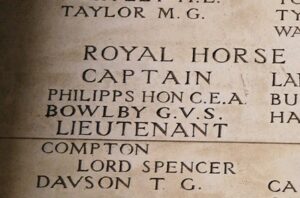
The Honorable Roland Erasmus Philipps, MC, Captain, Royal Fusiliers. Roland was born on 27 February 1890, the second son of John Philipps, the Right Honorable the 1st Viscount St. David’s, P.C. and his wife, Leonora Gerstenberg, of 3, Richmond Terrace, Whitehall, London. He was educated at Winchester College and New College, Oxford. Roland was an important early member of the Boy Scouts. In July 1912 he was appointed Assistant District Commissioner for East London. In 1913 he was appointed Commissioner for North East London, and in November 1913 he was made responsible for all of East London. Roland was commissioned into the 9th Battalion Royal Fusiliers, part of 36 Brigade, 12th Division. The Division assembled at Shorncliffe during August 1914 and moved to France at the end of May 1915. Their baptism of fire was at Ploegsteert Wood on 23 June 1915, and later at the Battle of Loos. They held the line at Loos until June, and they were moved in readiness for the Somme Offensive. They relieved the decimated 8th Division at Ovillers-la-Boiselle on 1 July, and took two lines of German trenches, but then stuttered to a halt. On 7 July 1916 the Brigade attacked again, but were decimated by German shell-fire in Mash Valley, but still managed to capture their objective of Ovillers. Roland was killed in Action this day, aged 26. He is buried in Aveluy Communal Cemetery Extension, Grave H. 32. His brother Colwyn also fell.
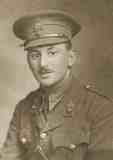
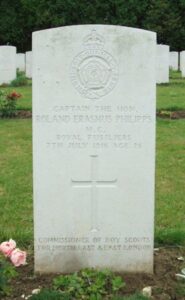
Joseph James Prescott, Private, 37520, Kings Liverpool Regiment. Joseph was born on 8 March 1897, the son of Joseph and Jane Prescott, of Southport, Cheshire. He was serving with the King’s Liverpool as a Private, based in Pembrokeshire when he met and married Edith Mary Williams, of Simpson, Roch, in the summer of 1917. Joseph was then transferred to the 571st Agricultural Company, Labour Corps. He didn’t serve overseas, but died on active service on 11 December 1918. Joseph was 21 years old, and is buried at Halsall (St. Cuthbert) Churchyard, England. Joseph is not commemorated on the Roch War Memorial.
Thomas John Rees, Private, 16035, Gloucestershire Regiment. Thomas was born at Roch, the son of John and Martha Rees. The family later resided at Bramble Hall, Sutton, Portfield Gate, Haverfordwest. Thomas enlisted at Haverfordwest into the 14th Battalion, Gloucestershire Regiment. The Battalion was raised at Bristol by the Citizens’ Recruiting Committee as a Bantam Battalion on 22 April 1915, joining 105 Brigade, 35th Division, and on 30 January 1916 landed at Le Havre. It saw its first major action during the Battle of the Somme, at the Battle of Albert. After some rebuilding of strength, the Division then went back into the line, and followed the German Retreat to the Hindenburg Line in March 1917. Later in the year they moved north to Ypres, and fought at the Second Battle of Passchendaele. By spring of 1918 they were back on the Somme, and fought at the First Battle of Bapaume, during the German Offensive. Thomas was killed during this terrible period, on 3 April 1918. He was just 21 years old, and is buried at Namps-Au-Val British Cemetery, France.
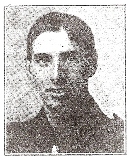
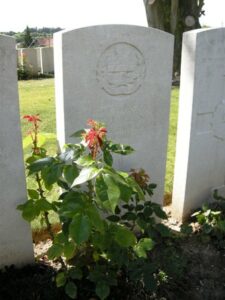
World War Two, 1939-1945
John George John, Private, 3959232, the Welch Regiment. John was the son of Henry and Mary John of Roch, Pembrokeshire. John served with the 1st Battalion, Welch Regiment, which was stationed at Mersa Matruh, Western Desert at the outbreak of war. The Battalion fought in the Western Desert campaign for its duration, and on the 10th June, 1943 took place in the Landings on Sicily. They fought their way up through Italy, during a hard and stubborn campaign by the Germans, who had dug themselves into well defended positions such as Monte Cassino. By November, 1943 the Battalion was withdrawn to Egypt, and remained there until 12 July 1944 when they sailed from Alexandria for Taranto. Again, they were pitched head first into the terrible fighting, slowly pushing north, and on 25 April, 1945 crossed the River Po. John was killed in action during this dogged campaign in Italy, on 20 June 1945. He was 30 years old, and is buried at Bari War Cemetery, Italy.
The Brothers Rawdon-Hastings
Lord St. David’s first wife Leonora Gerstenberg, the mother of Colwyn and Roland Erasmus Philipps, died in 1915. The following year he remarried Elizabeth Frances Rawdon-Hastings. The new Lady Elizabeth Frances Philipps, Baroness St. David’s, had two brothers who had fallen within weeks of each other during the Great War, and she erected a marble memorial plaque within St. Mary’s Church in their memory.
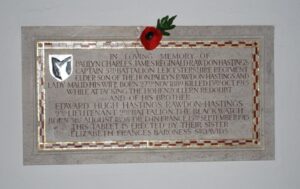
Edward Hugh Hastings Rawdon-Hastings, Second Lieutenant, Black Watch (Royal Highlanders). Edward was born on 31 August 1895, the younger son of the Hon. Paulyn Francis Cuthbert Rawdon-Hastings and Lady Maud Rawdon-Hastings, of 14, Stafford Mansions, Buckingham Gate, London. He was educated at Eton and Oxford before being commissioned into the 2nd Battalion, Black Watch from Sandhurst in 1914. Edward joined the battalion in France in the summer of 1915, where it was attached to the Bareilly Brigade, Meerut Division, after having spent several years in India. Edward joined the battalion near Loos, but contracted enteric fever, and was invalided to No. 14 Stationary Hospital at Wimereux, where he died on 15 September 1915, aged 20. Edward is buried at Wimereux Communal Cemetery, France. Edward had been awarded the King George V Coronation Medal, while acting as page to his uncle, the Earl of Loudoun.
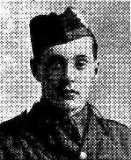
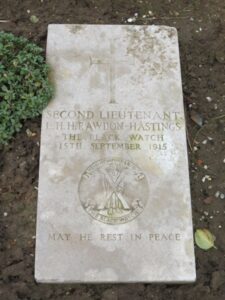
Paulyn Charles James Reginald Rawdon-Hastings, Captain, Leicestershire Regiment. Paulyn was born on 27 November 1889, the elder son of the Hon. Paulyn Francis Cuthbert Rawdon-Hastings and Lady Maud Rawdon-Hastings, of 14, Stafford Mansions, Buckingham Gate, London. He was educated at Eton and Oxford, before being commissioned into the 1/5th Battalion, Leicestershire Regiment. The battalion moved to France on 3 March 1915 as part of 138 Brigade, 46th (North Midland) Division, and moved to Hooge, east of Ypres, where it saw the Germans first use of flamethrowers on 30 July. The division then moved south to the Loos sector, to take part in the assault on the Hohenzollern Redoubt. Paulyn was killed at Loos while leading A Company in an attack on the redoubt on 13 October 1915. He was 25 years old, and is commemorated on the Loos Memorial, France. Paulyn was heir to his uncle, the Earl of Loudon.
